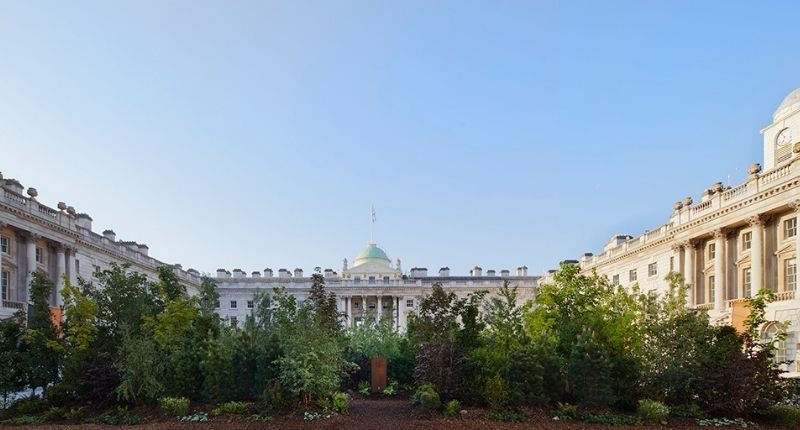
- The installation is part of London Design Biennale, from 1-27 June
- Famous landscape architects from Scape Design created the work
- United Nations SDG's a core part of the installation
The London Design Biennale returned for its third iteration this year.
Delayed by Covid, Somerset House hosted a pulchritudinous display of Mother Nature in the famous courtyard.
Conceived by artist Es Devlin, and brought to life by landscape designer Philip Jaffa, founder of Scape Design, Forest for Change is an installation of more than four hundred trees that leads to The Global Goals Pavillion, all set amidst four boundaries of neoclassical Britain.
The Biennale
Since 2016, the London Design Biennale “promotes international collaboration and the global role of design with exhibitions and installations that ‘demonstrate the ambition to create universal solutions to problems which concern us all.'”
This year, Biennale artistic director Es Devlin chose resonance as the theme.
“We live in an age of hyper resonance, the consequences of which are both exhilarating and devastating.”
Es Devlin, London Design Biennale Artistic Director
Ms Devlin said resonance can be used as a tool for positive change, creating a more sustainable future.
A court-forest like no other
The installation comprises more than four hundred juvenile trees, mostly from the United Kingdom.
The designers said, “[The trees] have been individually selected for their differing canopy shapes, heights and forms to achieve a layered aesthetic and to shroud the glade where the Development Goals lie at the heart of the experience.”

The diversity of trees is considerable, 27 different species were selected “diverse range of 27 nursery grown species with the aim of ensuring resilience in the London environment. These include many favourite common species such as Scots Pine, Hazel and Silver Birch.”
“The only way to ensure future resilience of our new forest and tree plantings is to plant as much diversity of species as possible.”
Tony Kirkham, MBE, VMH, Head of Arboretum, Gardens & Horticulture Services, Royal Botanic Gardens
Exhibiting quintessential British woodlands, Forest for Change will feature “a sculptural array of logs and branches will also be spread across the ground to suggest the sights and smells of centuries-old woodlands.”
Visitors will also be enraptured by a birdsong soundtrack curated by Brian Eno.

Forest for Change didn’t come without some controversy though, Dezeen reported Klaus Littmann raised concerns over its similarity to his 2019 project in Austria which saw a football stadium similarly adorned with trees.
Ms Devlin, however, told Dezeen she believed it was different in a number of ways, including the interactive elements, pathways, and illuminations. Ms Devlin also said that the intention behind the installation is “diametrically distinct from Peintner’s conjecture…”.
A more playful ‘controversy’ stems from the genesis of Somerset House itself.
Mr Jaffa said, “The irony of constructing a forest in a courtyard where Enlightenment principles meant trees were forbidden when Somerset House was built has not been lost on us.”
“The forest represents a challenge to the presumption that we are here to dominate nature, rather than as an integral part of it.”
Philip Jaffa, Founder, Scape Design
The irony was much more strongly addressed in the Biennale description of the installation, Ms Devlin and the team “subverted” the rules of Somerset House set back in 1776 by architect William Chambers, precluding the inclusion of trees.
“The UN Global Goals offer us clear ways to engage and alter our behaviour and it is our hope that an interaction with the Goals in the forest will be transformative.”
Es Devlin, London Design Biennale Artistic Director
Sustainable development goals
The United Nations developed the 17 Sustainable Development Goals (SDG) as part of the 2030 Agenda for Sustainable Development back in 2015.
Targeting a number of key elements to a better future, the United Nations created a framework for everyone to work towards a better, fairer, future for all.
The pavilion at the centre of the forest installation features seventeen pillars representing each of the goals.

London Design Biennale said, “Bringing trees into the courtyard at Somerset House for the first time is a bold statement that mirrors the audacious nature of the Global Goals – an ambitious plan agreed to by all nations to create a better and fairer world for all by 2030.”
“counter this attitude of human dominance over nature, by allowing a forest to overtake the entire courtyard.”
Es Devlin, London Design Biennale Artistic Director
Green cities at home
Forest for Change is not the usual abstraction one may expect from an art installation, instead, the centrepiece, along with The Global Goals Pavillion, is a fine expression of both the resonance theme and global goals.
London is the world’s first National Park City, Adelaide is likely to be hot on the heels of the city as second National Park City.
The subject is considered of great importance, as recently in Melbourne, some have been calling for increased greening as a solution to the biodiversity crisis.
It is not so simple as to put a few trees up in a national park, harshly demarcating between human lives and others, as that ignores the ecosystems that previously thrived where cities currently lie.
That divide is a poignant point of concern, with cities creating kilometres long parks to reintroduce greenery and nature into otherwise baron concrete jungles.
Hundreds of millions of dollars have also been spent across the eastern seaboard of Australia, in March, the City of Sydney committed $377 million to turn Sydney into a green wonderland.
Other local governments have also been involved in the greenery effort, many councils around Australia offering free trees to plant at home, offering the opportunity to contribute in our own way.







